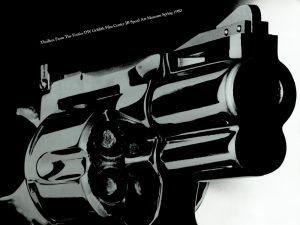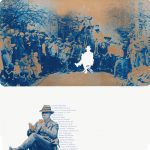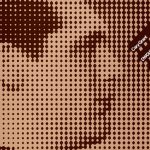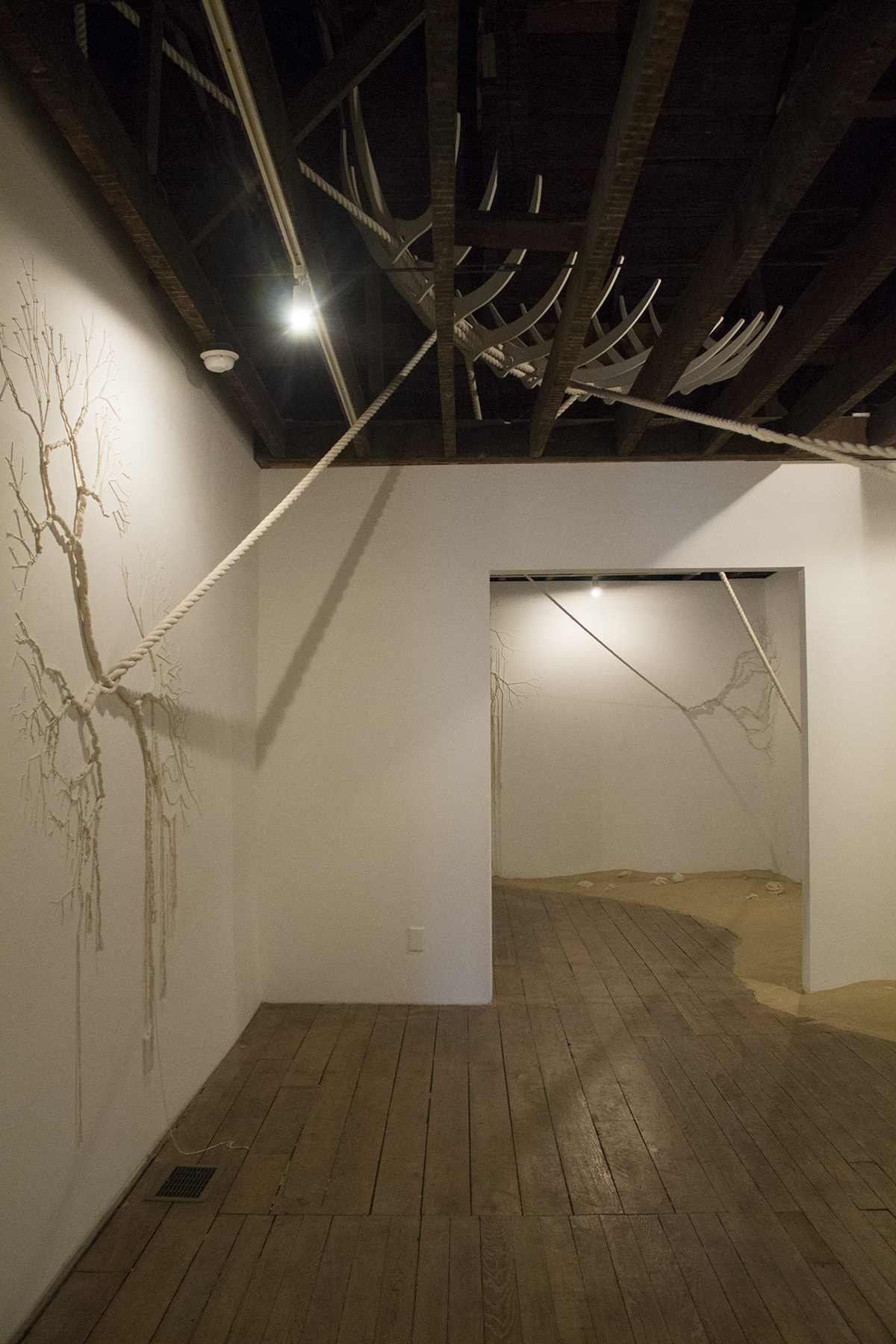The lobby of the Frazier History Museum.
Julius Friedman: Fifty-Year Retrospective
Review by Keith Waits
Text copyright © 2016 Keith Waits. Images copyright © 2016 Julius Friedman. All rights reserved.
If you lived in Louisville in the late 70’s and early 80’s, odds are your walls featured the work of Julius Friedman. Whether in expensive wood and glass frames inside well-to-do homes, or thumbtacked to the walls of rented apartments, posters he designed for the Kentucky Derby Festival, the Louisville Orchestra, the Louisville Ballet, the J.B. Speed Museum, and the Louisville Visual Art Association were seen all over town. Now The Frazier History Museum is hosting a retrospective of that work, as well as giving Friedman three spaces that feature more recent projects.
Once you get past the entry and the gift shop of Frazier History Museum, the walls throughout the lobby are
 covered with a full retrospective of Julius Friedman’s work as a poster designer, the range of which is astonishing when given the opportunity to see so much of it in one location. This is the work that made Friedman’s reputation and, we can only hope, a tidy fortune, and it is fascinating to see how it both reflects and follows American graphic design trends from the period while always remaining uniquely Julius Friedman.
covered with a full retrospective of Julius Friedman’s work as a poster designer, the range of which is astonishing when given the opportunity to see so much of it in one location. This is the work that made Friedman’s reputation and, we can only hope, a tidy fortune, and it is fascinating to see how it both reflects and follows American graphic design trends from the period while always remaining uniquely Julius Friedman.
The posters stretch around all the walls, including hallways leading to the bathrooms, as if no one area could possibly contain them. Going back to when The Speed Museum hosted film series’ in their D.W. Griffith Film Center in the late 1970’s and early 1980’s, Friedman’s work catalogs the design tropes of the time, with the reductive transposition of Griffith himself from an historical image, or a Ben Ray-Dot profile of Cary Grant, but a dramatic, close-up of a .38 caliber revolver to represent Hollywood thrillers from the 1940’s would likely not fly in today’s politically charged culture, even if it perfectly evokes the aesthetic of Film Noir.
Of course, the most famous images, certainly to Louisville residents of a certain age, are the iconic designs for local arts companies that in of themselves became standard-bearers for the halcyon days of arts growth in the city: a french horn serving up an impossible array of ice cream scoops in the bell of the horn, the Dali-esque DinnerWorks poster for Louisville Visual Art’s long-running ceramics exhibit, or the exquisitely balanced ballerina’s foot on pointe atop a single egg. And speaking of eggs, was there ever a more sensuous depiction of the organic, plasticity of liquid medium than Freidman’s “Fresh Paint”?
 In powerful contrast to the openness and salon style poster presentation, there are three contained gallery spaces housing unique installations of Friedman’s more contemporary, often abstract work. In the first, westernmost room, widescreen panels of color images printed onto aluminum hang on the walls surrounding metallic, iridescent material falling from the ceiling amongst large three-dimensional forms. These include cubes featuring more of the artist’s images, all nestled in fields of multicolored glass shards. The lighting on these forms and images is controlled with such specificity that it takes a moment to comprehend that there are no labels, signs, or curatorial statements on the walls, which themselves seem to recede from understanding. The atmosphere is established with such resolve that none of the individual pieces read as such, rather they exist as part of the installation.
In powerful contrast to the openness and salon style poster presentation, there are three contained gallery spaces housing unique installations of Friedman’s more contemporary, often abstract work. In the first, westernmost room, widescreen panels of color images printed onto aluminum hang on the walls surrounding metallic, iridescent material falling from the ceiling amongst large three-dimensional forms. These include cubes featuring more of the artist’s images, all nestled in fields of multicolored glass shards. The lighting on these forms and images is controlled with such specificity that it takes a moment to comprehend that there are no labels, signs, or curatorial statements on the walls, which themselves seem to recede from understanding. The atmosphere is established with such resolve that none of the individual pieces read as such, rather they exist as part of the installation.
Next, in a live presentation space designed for small audiences, Friedman projects film (a new medium for him) in four directions. The abstract textures are from the surface of a creek on Friedman’s property, and the experience is as immersive as the first space; perhaps even more so. The viewer’s senses are slightly overwhelmed when surrounded by the moving images, which encompass the walls floor-to-ceiling. Friedman has draped fabric over permanently installed bleachers on the north side, so that the image is broken up in intriguing ways by the horizontal lines.
In the final room, large, translucent material hangs in the center, while more conventional displays offer a quantity of material from Friedman’s most recent, The Book. An exhibit that has been published as both a limited edition, hand-bound collection, and a standard, hard-bound book form, it is another startling example that Friedman, who made his name as a two-dimensional artist and designer, has so fully embraced the third dimension in his most recent work. The Book is comprised of photographs of numerous discarded volumes; antiquated but of no value, which the artist has subjected to all manner of abuse, including setting them aflame; manipulating them into sometimes unrecognizable constrictions. It is one of the more thorough deconstructions of ubiquitous form you are likely to find. It took Friedman a long time before he could bring himself to violate the integrity of such revered artifacts, and it is precisely this sense of breaking taboo that is the foundation of the work’s power. As worshipful as we may be about books, building entire cathedrals of knowledge to house them, we also take their presence in our lives for granted, and, in a time when new generations are turning more and more to digital screens to read, the underlying themes of death and destruction are provocative commentary on our times.
http://www.imagesol.com
Julius Friedman: Fifty-Year Retrospective
June 24 – October 9, 2016
Open Mon.- Sat. 9am – 5pm | Sundays Noon – 5pm
Frazier History Museum
829 West Main Street
Louisville, KY 40202
Fraziermuseum.org
(502) 753-5663
Keith Waits is a native of Louisville who works at Louisville Visual Art during the days, including being the host of PUBLIC on WXOX-FM 97.1/ ARTxFM.com, but spends most of his evenings indulging his taste for theatre, music and visual arts. His work has appeared in Pure Uncut Candy, TheatreLouisville, and Louisville Mojo. He is now Managing Editor for Arts-Louisville.com.







